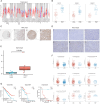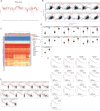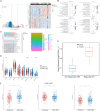Epigenetic modification of Castor zinc finger 1 (CASZ1) is associated with tumor microenvironments and prognosis of clear cell renal cell carcinoma
- PMID: 39235847
- PMCID: PMC11745609
- DOI: 10.1097/JS9.0000000000002070
Epigenetic modification of Castor zinc finger 1 (CASZ1) is associated with tumor microenvironments and prognosis of clear cell renal cell carcinoma
Abstract
Background: Clear cell renal cell carcinoma (ccRCC) represents the predominant and remarkably diverse form of renal cell carcinoma. The involvement of the Castor zinc finger 1 (CASZ1) gene in adverse prognostic outcomes has been observed across different cancer types. Nevertheless, the specific altered activities and associated multi-omics characteristics of CASZ1 in ccRCC remain unelucidated.
Method: In order to explore the expression of CASZ1, evaluate its prognostic significance, and aid in the therapeutic decision-making process for patients with ccRCC, The Cancer Genome Atlas (TCGA), Gene expression omnibus (GEO), and The Human Protein Atlas (HPA) databases were utilized to gather data on clinicopathological data, prognostic information, genomic, methylomic and immunomic data. Additionally, the Genomics of Drug Sensitivity in Cancer (GDSC) database provided information on drug sensitivity.
Results: CASZ1 expression was found to be significantly reduced in ccRCC and was associated with unfavorable pathological characteristics and a bleak prognosis. Diminished CASZ1 mRNA levels were notably correlated with heightened cytosine-phosphate-guanine (CpG) methylation, indicating a poorer prognosis for patients with increased methylation. Examination of RNA-seq data from TCGA indicated that the CASZ1-high expression subgroup displayed heightened immune cell infiltration and increased expression of immune checkpoint markers, potentially suggesting a more favorable response to immunotherapy. Furthermore, data from the GDSC database indicated that the CASZ1-low expression subgroup might exhibit greater sensitivity to anti-angiogenetic treatments, such as Sunitinib and Axitinib.
Conclusions: These results indicate that CASZ1 may function as a biomarker for distinguishing various tumor microenvironment phenotypes, predicting prognosis, and assisting in treatment decisions for individuals with ccRCC.
Copyright © 2024 The Author(s). Published by Wolters Kluwer Health, Inc.
Conflict of interest statement
The authors have declared that no conflicts of interest exist.
Sponsorships or competing interests that may be relevant to content are disclosed at the end of this article.
Figures



Similar articles
-
The Prognostic Significance of Protein Expression of CASZ1 in Clear Cell Renal Cell Carcinoma.Dis Markers. 2019 Aug 6;2019:1342161. doi: 10.1155/2019/1342161. eCollection 2019. Dis Markers. 2019. PMID: 31481981 Free PMC article.
-
Integrated multi-omics analyses reveal that BCAM is associated with epigenetic modification and tumor microenvironment subtypes of clear cell renal cell carcinoma.Clin Epigenetics. 2022 Aug 8;14(1):99. doi: 10.1186/s13148-022-01319-2. Clin Epigenetics. 2022. PMID: 35941663 Free PMC article.
-
ERBB2 is a potential diagnostic and prognostic biomarker in renal clear cell carcinoma.Sci Rep. 2024 Oct 1;14(1):22775. doi: 10.1038/s41598-024-73574-7. Sci Rep. 2024. PMID: 39353993 Free PMC article.
-
High expression levels of DEF6 predicts a poor prognosis for patients with clear cell renal cell carcinoma.Oncol Rep. 2020 Nov;44(5):2056-2066. doi: 10.3892/or.2020.7736. Epub 2020 Aug 18. Oncol Rep. 2020. PMID: 33000227 Free PMC article.
-
Epigenetic modification of PHLDA2 is associated with tumor microenvironment and unfavorable outcome of immune checkpoint inhibitor-based therapies in clear cell renal cell carcinoma.Eur J Med Res. 2024 Jul 20;29(1):378. doi: 10.1186/s40001-024-01939-9. Eur J Med Res. 2024. PMID: 39033192 Free PMC article.
Cited by
-
A systematic review of the latest progress of drug resistance and clinical application of immunotherapy in renal cell carcinoma in the past five years based on bibliometrics.Hum Vaccin Immunother. 2025 Dec;21(1):2532954. doi: 10.1080/21645515.2025.2532954. Epub 2025 Jul 16. Hum Vaccin Immunother. 2025. PMID: 40667694 Free PMC article.
-
The role and mechanism of NAT10-mediated ac4C modification in tumor development and progression.MedComm (2020). 2024 Dec 4;5(12):e70026. doi: 10.1002/mco2.70026. eCollection 2024 Dec. MedComm (2020). 2024. PMID: 39640362 Free PMC article. Review.
References
-
- Barata PC, Rini BI. Treatment of renal cell carcinoma: current status and future directions. CA Cancer J Clin 2017;67:507–524. - PubMed
-
- Moch H, Cubilla AL, Humphrey PA, et al. . The 2016 WHO Classification of Tumours of the Urinary System and Male Genital Organs-Part A: Renal, Penile, and Testicular Tumours. Eur Urol 2016;70:93–105. - PubMed
MeSH terms
Substances
LinkOut - more resources
Full Text Sources
Medical

